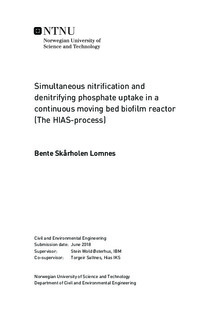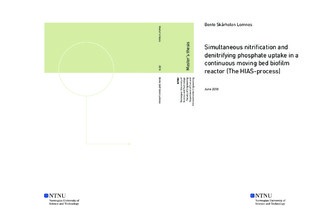| dc.description.abstract | Nutrients such as nitrogen (N) and phosphorus (P) can cause eutrophication and harmful algal blooms in waterbodies. Removal of these nutrients from wastewater discharges are therefore necessary to insure healthy waters. The increased focus on the world s limited phosphate reserves have led to an increased interest for biological phosphorus removal enhancing P-recovery from wastewater. A newly developed biological phosphorus removal process, the HIAS-process, has shown good removal for phosphorus, but have also detected some nitrogen removal. By enhancing removal of nitrogen in this process, the process could be a more compact and cost-effective treatment option compared to today s treatment processes for both phosphorus and nitrogen.
In this study, three main parameters influencing the HIAS-process were investigated to get further knowledge about the process, so that an optimization of N-removal in the process could be done. The parameters investigated were anaerobically carbon consumption, oxygen concentrations and temperature, and were investigated through batch experiments at the laboratory and grab sample experiments in the pilot plant at HIAS Wastewater Treatment Plant.
Results show that high oxygen concentration gives high nitrification rates, which results in a high production of nitrite/nitrate. It is also seen that higher denitrification rates are present when the nitrite/nitrate concentrations are initially higher. However, high oxygen concentration over time does indicate that lack of an anoxic layer in the biofilm could occur when oxygen consumption by nitrifyers and phosphate accumulating organisms (PAOs) decreases. This further decreases the denitrification, due to the need for an anoxic layer to be present for denitrification to occur. Experiments conducted with initially high oxygen concentration, followed by low oxygen concentration, showed that better N removal could occur due to maintenance of the anoxic layer.
Results from the batch experiments show that higher anaerobically carbon consumption gives higher denitrification rates and that carbon taken up in the anaerobic period can effectively be utilized for N removal, with a potential C/N-ratio found in the batch experiments to be approximately 5 mg sCOD/mg N. Results have also shown higher N removal efficiencies under higher temperatures.
The results from the experiments performed in this thesis give reasons to believe that optimization of the process could be done by controlling the DO concentration in the aerobic period of the reactor, to have high oxygen concentrations in the first chambers, and lower oxygen concentrations in the last chambers. Optimization of the process can also be done by adding an external carbon source if the organic carbon load into the reactor has too low capacity to remove the desired amount of ammonium. The aerobic retention time can also be extended to improve the nitrogen removal. | |

